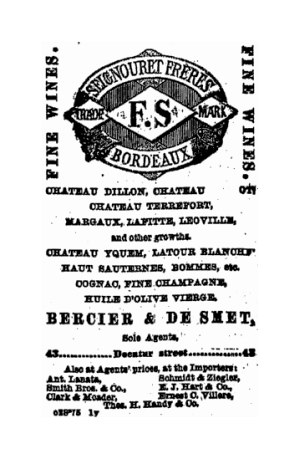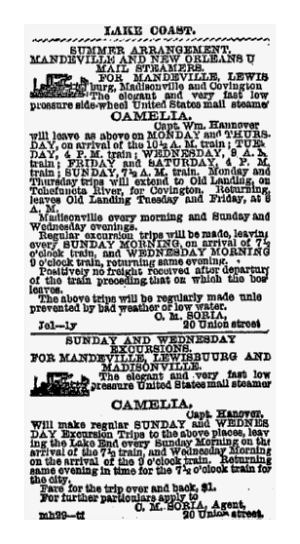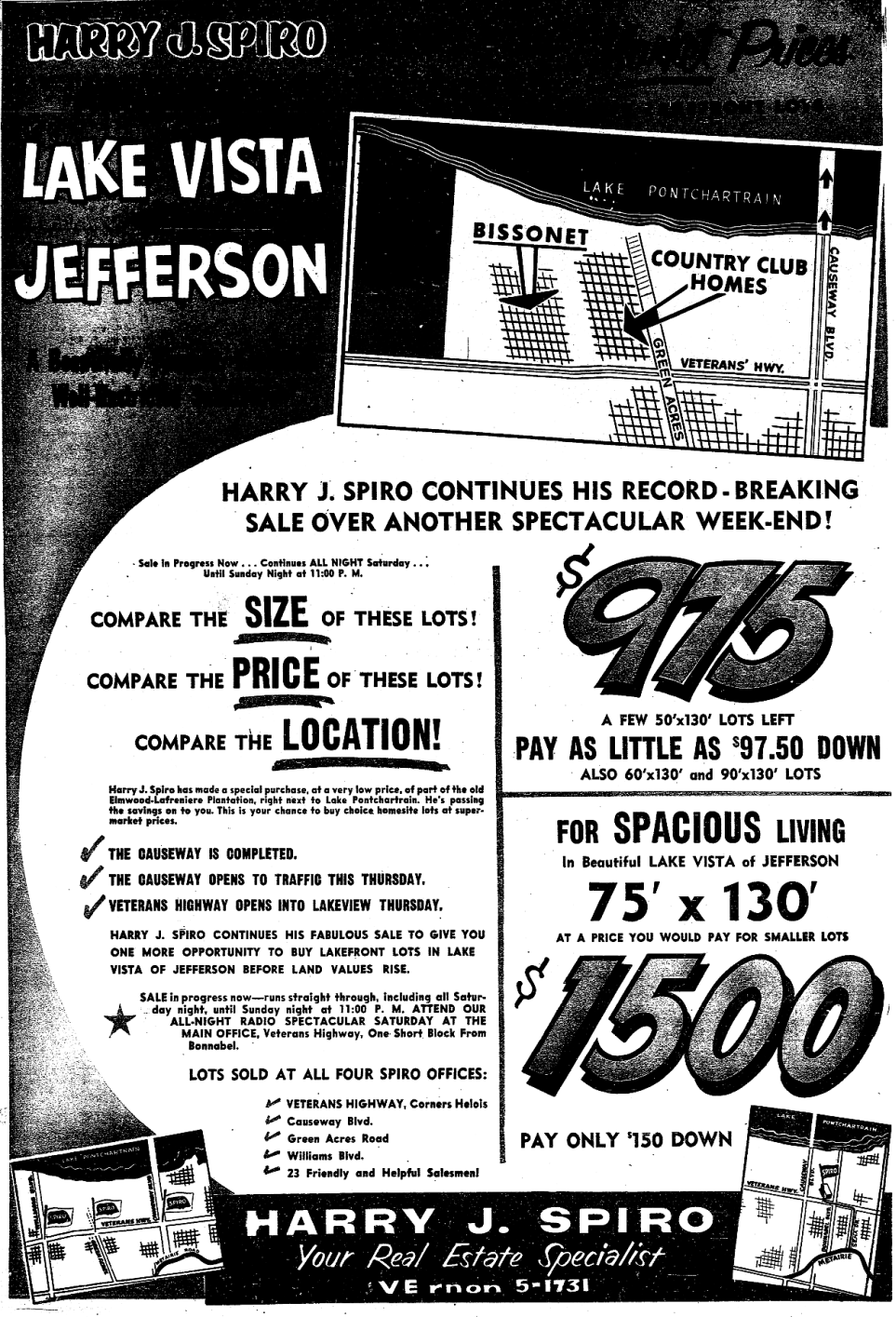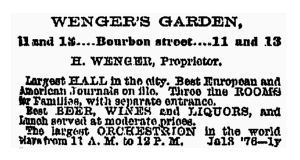
Harry J. Spiro
"The
Greatest Name in Jefferson Real Estate"
August
26, 1956
Sunday, August 26, 1956 -- Times-Picayune
On October 25, 1955 Harry J. Spiro, Jr. incorporated his real estate company. He then set up field offices
along the new Veterans Highway -- the main one on at 805 Helios (at his home) at Veterans, a second at Athania and the highway,
and a third at Green Acres Road and Veterans. He offered free orchids to the ladies who visited. "A lot depends
on you" he stated in advertisements which boasted of the "Greatest name in Jefferson Real Estate". During
the mid-1950s Spiro bought and sold lots in Green Acres, Pontchartrain Gardens, Taft Park, Harlem Park, on Veterans, Transcontinental,
Clearview, Harvard, Claudius, Citrus, and other locations including near Causeway and Vets. In 1957 he bought 66 acres of
cow pasture in what was the Elmwood/Lafreniere plantation.
Spiro's
earlier ventures included a stint selling real estate for A.K. Roy and running Pine Side Day Camp (a nursury and summer camp)
and Pine Ridge Picnic Ground, both from his home on Helios Street which which sat amid much undeveloped land. In 1954
his father, also a realtor, sold him eight lots at Bonnabel Place subdivision.
Spiro, Sr., at age 65 was murdered by stabbing with a hunting or fishing knife on February 27, 1957 in his
office at 1918 Tulane Avenue. Spiro, Jr. offered a $500 reward for information regarding the crime. He upped it to $2,500,
and in 1959 offered $10,000 but the murder, which had attracted much local attention was never solved.
Harry Jr's. business was good but pick up dramatically in 1958 when he decided to pull off a radio "saturation"
of advertising via WTIX. With guidance from O.W. Joslyn, president of the Joslyn advertising agency, he inspired what
he called a "radio inspired land rush" to sell $400,000 worth of Metairie property. Spiro bought air time
for 30 one-minute ads and seven one-hour live remote broadcasts to run on weekends and nights at a cost of $1000. Popular
broadcaster and announcer Larry Wilson hosted the commercials. During the first week of broadcasts, 60 of 226 lots were bought
for a total of $250,000 in sales.
By 1967, Spiro was selling
land to Chateau Builders and in Pontchartrain Shores, Palm Vista, Airline Park, and Highway Park subdivisions after having
sold 33 lots in Elmwood Park to Delta Title Agency for $245,000. In 1972, Harry married a much younger (college student)
Brigitte "Cookie" O'Quin from Evangeline Parish. The same year they moved to New York City.
Born in New Orleans in 1924, Spiro attended Tulane before serving in the Marine Corps during World War II
(from 1943 to 1946), then attended Dartmouth College in 1947 (where he gave his address as 3764 Veterans Highway). After
buying and selling so much land in Metairie and moving away from the area, Harry and his wife became art collectors and dealers
(see
The Burchfield Collectors for more information). Their daughter Jordana is an actress. Harry J. Spiro, Jr. passed away in 2001.


On Friday, August 26, 2005 the Louisiana state Executive Department in Baton Rouge issued
Proclamation No. 48 KBB: State of Emergency -- Hurricane Katrina. In the early afternoon, the National Hurricane Center officially
shifted the possible track of Katrina from the Florida Panhandle to the Mississippi/Louisiana coast. Governor Kathleen Babineaux
Blanco declared a state of emergency for the state of Louisiana. The declaration included activation of the state of Louisiana's
emergency response and recovery program under the command of the director of the state office of Homeland Security and Emergency
Preparedness to supply emergency support services. Following the declaration of a state of emergency, federal troops were
deployed to Louisiana to coordinate the planning of operations with the Federal Emergency Management Agency (FEMA). 922 Army
National Guard and 8 Air National Guard were deployed. By 11:00 PM EDT, the National Hurricane Center predicted that Hurricane
Katrina would strike the town of Buras-Triumph, Louisiana, 66 miles (106 km) southeast of New Orleans. (Wiki)
The White House issued a statement, effective August 26, 2005 authorizing federal emergency assistance
for Louisiana. The statement authorized the Department of Homeland Security (DHS) and the Federal Emergency Management Agency
(FEMA) to coordinate disaster relief and "...required emergency measures, authorized under Title V of the Stafford
Act, to save lives, protect property and public health and safety, or to lessen or avert the threat of a catastrophe in
the parishes of Allen, Avoyelles, Beauregard, Bienville, Bossier, Caddo, Caldwell, Claiborne, Catahoula, Concordia, De Soto,
East Baton Rouge, East Carroll, East Feliciana, Evangeline, Franklin, Grant, Jackson, LaSalle, Lincoln, Livingston, Madison,
Morehouse, Natchitoches, Pointe Coupee, Ouachita, Rapides, Red River, Richland, Sabine, St. Helena, St. Landry, Tensas, Union,
Vernon, Webster, West Carroll, West Feliciana, and Winn." This includes all the parishes in the state of Louisiana
except the coastal parishes which are inherently exposed to the most destructive forces of a hurricane. The President had
not yet authorized FEMA to enter the coastal areas despite the governor's request including those parishes. The governor
activated the National Guard with her August 26, State of Emergency Declarati0n Red Cross relief in New Orleans remains forbidden
by the Governor.
In 1995 the Housing Authority of New Orleans (HANO) received the lowest scores of all other major housing
authorities in the U.S. by the federal department of Housing and Development (HUD). On August 26, 1995
HANO announced that it was contemplating demolition of some of the cities 'projects' buildings. The process began later
in the year with the removal of some units in the Desire project. In 1997 another 252 were demolished. The following
year 408 units came down. By 2003 Desire was completely demolished save for three original buildings. In 2004
107 new units were built and the original buildings were scheduled for demolition. Hurricane Katrina inundated what
remained. At an original cost of $24 million, Desire was built on the site of the Hideaway Club where Fat's Domino had regularly
performed. The club was demolished in 1949 to make way for Desire. (Wiki)
August 26th, 1992 (Andrew): Andrew, a major hurricane, slammed into South Florida
on August 24th before striking the Louisiana coastline August 26th. Seven people died and 94 were injured across Southern
Louisiana during Andrew. Winds reached hurricane force from Lafayette eastward to the Atchafalaya. The highest gusts
reported were: 39 m.p.h. at Lake Charles Regional Airport, 66 m.p.h. at Moisant International Airport in New Orleans,
71 m.p.h. at Lafayette Regional Airport, 83 m.p.h. at Salt Point in St. Mary Parish, 104 m.p.h. at the Lafayette Parish
Courthouse, 153 m.p.h. at the New Iberia Emergency Operating Center, and 173 m.p.h. at the Drilling Barge on Bayou Teche
in St. Mary Parish. Rainfall totals from Andrew exceeded 5 inches over a four day period from August 24-28
in many locations...with Robert receiving 11.02" and Hammond receiving 11.92". The storm surge moved inland from
Lake Borgne westward to the Vermilion Bay...the highest surge reported was at 6.48 feet at Bayou Dupre. An F3 tornado
struck LaPlace and stayed on the ground until reaching Reserve in St. John the Baptist Parish which caused 2 of the deaths.
Around 1 1/2 million people evacuated across Southern Louisiana with damages estimated near 1 billion dollars in Louisiana.
(NOAA)
Loius Prima was buried in Greenwood Cemetery on August 26, 1978. Reverend Monsignor
Harrison A. Martin officiated over the ceremonies.
For $3.00 per ticket one could watch both Foghat and Flesh perform at A Warehouse on Tchouptioulas Street
at the river on Saturday, August 26, 1972. The show started at 8:00 P.M.
Airline Highway originally was a two-lane road that ran from Prairieville to Shrewsbury (now Metairie).
The first section, running between Williams Boulevard in Kenner and Shrewsbury Road, opened in June 1927. It was begun
by the Jefferson Parish Police Jury as a local road and incorporated into the plan for Airline Highway during construction.
The remainder of the highway was built between 1928 and 1933 by the Louisiana Highway Commission with federal aid, as the
road would carry US 61 upon completion. The section north of the spillway was officially opened on July 4, 1933, and the
section on the south side followed three weeks later. (Various sections had been temporarily opened to traffic beginning
in October 1931.) Completion of the bridge over the Bonnet Carré Spillway was delayed until 1935, necessitating
a detour over the Jefferson Highway (River Road) via temporary gravel roads along the spillway guide levees. The eight-lane
extension into Tulane Avenue (reached by a now-demolished six-lane bridge over the former New Basin Canal) was officially
opened on August 26, 1940.
Originally Airline Highway was a two-lane road that ran from Prairieville to Shrewsbury (now Metairie).
The first section, running between Williams Boulevard in Kenner and Shrewsbury Road, opened in June 1927. It was begun by
the Jefferson Parish Police Jury as a local road and incorporated into the plan for Airline Highway during construction.
The remainder of the highway was built between 1928 and 1933 by the Louisiana Highway Commission with federal aid, as the
road would carry US 61 upon completion. The section north of the spillway was officially opened on July 4, 1933, and the
section on the south side followed three weeks later. (Various sections had been temporarily opened to traffic beginning in
October 1931.) Completion of the bridge over the Bonnet Carré Spillway was delayed until 1935, necessitating a detour
over the Jefferson Highway (River Road) via temporary gravel roads along the spillway guide levees. The spillway bridge
was opened to traffic on September 28, 1935 and was dedicated on December 13, 1935. The eight-lane extension into Tulane
Avenue (reached by a now-demolished six-lane bridge over the former New Basin Canal) was officially opened on August
26, 1940.

Bercier & De Smet, general
importers, ran one of the finest fancy grocery and general stores in New Orleans when this ad was run on August 26,
1876. Located at 43 Decatur Street (near the Custom House) the store sold both wholesale and retail, offering
champagne, wine, cordials, sherry, brandy, vermouth, rum, whiskey, ale, stout, and bitters as well as olive oil, fruits, vegetables,
soap, and more. The store was first opened in 1874 by Paul Gelpi and Bro.

The August 26, 1876 ad below provides the schedule for the Camelia, a side-wheel steamboat
which ran between "Lake End" (we know it as West End) and the Northshore. It carried U.S. mail daily between
the cities of Mandeville, Lewsiburg, Madisonville, Covington, and New Orleans. The "elegant and very fast"
steamer carried people twice each week. On Sundays the boat departed from West End at 7:30 A.M. and boarded to return at
7:30 P.M. -- depending upon the punctuallity of the railroad which carried people to and from it. An identical excursion
ran on Wednesdays, leaving New Orleans at 7 A.M. Cost there and back -- $1.
Admission was free to Wenger's large ("Three fine rooms") beer garden/concert saloon.
This August 26, 1876 advertisement boasts of "The largest Orchestrion in the world" on Bourbon
Street (near Canal Street). An 'orchestrion" is a large mechanical musical instrument designed to imitate
the sound of an orchestra. Wenger's device was a pipe organ which was described in an 1869 New Orleans Republic newspaper
article as "the remarkable machine known as the self-acting organ".
Elizebeth Smith Friedman, born on August 26, 1892, "America's first female
cryptanalyst" [code breaker]. Her testimony in cases in Galveston, Houston, and New Orleans in 1933 resulted in
convictions against thirty-five bootlegging ringleaders who were found to have violated the Volstead Act. Ringleaders were
directly linked with suspected shipping vessels as a result of the information arising out of her analysis. She died on October
31, 1980. Related reading: An Encyclopedia of American Women at War [2 volumes]: From the Home Front to the Battlefields










